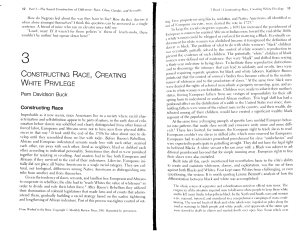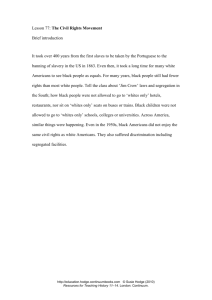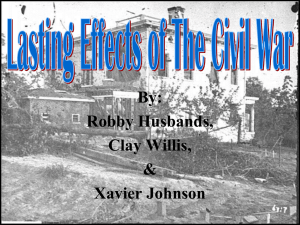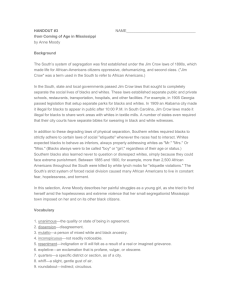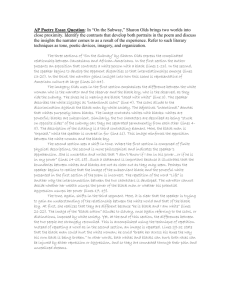constructing race, creating white privilege
advertisement
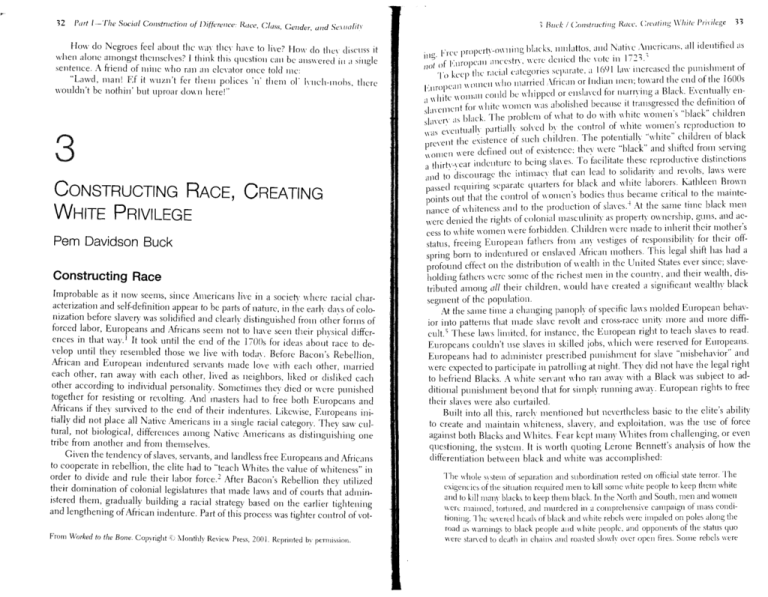
.-'
32
Part I -The Social Construction or Di!f<:renee: Haee, Class, Gender, and SOl/alii)'
HOIv cIo Negroes feel about the wa\ thcv have to live? How clo the\ discuss it
when alone amongst themselves? I think this question can be answered ill a single
sentence. A friend of mine who ran an elevator once told me:
"Lawd , man! Ff it wuzri't fer them polices 'n' them 01' lvuch-mobs, there
wouldn't be nothin' but uprom clown here!"
3
CONSTRUCTING RACE, CREATING
WHITE PRIVILEGE
Pem Davidson Buck
Constructing Race
Improbable as it now seems, since Americans live in a society where racial char­
acterization and self-definition appear to be parts of nature, in the earlv davs of colo­
nization before slavery was solidified and clearly distinguished [rom other tonus of
forced labor, Europeans and Africans seem not to have seen their physical differ­
ences in that way.' It took until the end of the I700s for ideas about race to de­
velop until they resembled those we live with todav. Before Bacon's Rebellion,
African and European indentured servants made love with each other, married
each other, ran away with each other, lived as neighbors, liked or disliked each
other according to individual personality. Sometimes they died or were punished
together for resisting or revolting. And masters had to free both Europeans and
Africans if they survived to the end of their indentures. Likewise, Europeans ini­
tially did not place all Native Americans in a single racial category. They saw cul­
tural, not biological, differences among Native Americans as distinguishing one
tribe from another and from themselves.
Given the tendency of slaves, servants, and landless free Europeans and Africans
to cooperate in rebellion, the elite had to "teach Whites the value of whiteness" in
order to divide and rule their labor force 2 After Bacon's Rebellion they utilized
their domination of colonial legislatures that made laws and of courts that admin­
istered them, gradually building a racial strategy based on the earlier tightening
and lengthening of African indenture. Part of this process was tighter control of votFrom Worked to the Bone,
Copyright
Monthl«
Review Press, 2001. Reprinted bv permission.
:; Buck / Constructins; Race, Creating While Privilee«
B
in". Frce propertHl\vning blacks, mul.ittos. amI Native Al_llerieans, all identified as
,](~ of 1':nropC<lIl .mr-cstrv, were denied the vote in 172i.'
To keep the raeial categories separate, a 16(,)1
increased the punishment of
Enropean \\Olllen \\ho lllarri.ed African or Indian men; toward the en~1 of the I600s
a white \\OJn,lll r-ould be whipped or enslaved for marrnng a Black. Fvcnluallv en­
sla\CIllent for white women was aholished because it transgressed the definition of
slaven ,IS hlack. The problem of what to do \vith white women's "black" children
:\as c'vcntualk partialh solved by the eontrol of white women's reproduction to
pre\'ent thc existence of such children, The potentiallv "white" children of black
\\Olllen "ere defined out of existence: thcv were "black" and shifted from serving
a thirtHear indenture to being slaves. To f,lcilitate these reproductive distinctions
,md to discouragc the intimae. that can lead to solidarity and revolts, laws were
passed requiring separate quarters for black and white laborers, Kathleen Brown
points out that the control of women's bodies thus became critical to the mainte­
nance of whitencvs and to the production of slaves." At the same time black men
wcrc denied the rights of colonialmasculinih' as property ownership, guns, and ac­
cess to white women we-re forbidden. Children were made to inherit their mother's
status, freeing European fathcrs from dny vestiges of responsibility for their off­
spring born to indentured or enslaved African mothers, This legal shift has had a
profound cffect on the distribution of wealth in the United States ever since; slave­
holding fathers were some of thc richest men in the countrv, and their wealth, dis­
tributed among all their children, would have created a significant wealthv black
"1\\'
segment of the population.
At the same time a changing panoply of specific b\\'s molded European behav­
ior into patterns that made slave revolt and cross-race unity more and more diffi­
cult.' These laws limited, for instance, the European right to teach slaves to read.
Europeans couldn't use slaves in skilled jobs, which were reserved for Europeans.
Europeans had to administer prescribed punishmcnt for slave "misbehavior" and
were expected to participate in patrolling at night. They did not have the legal right
to befriend Blacks. A white servant who ran awav with a Black was subject to ad­
ditional punishment bevond that for simplv running away. European rights to free
thcir slaves were also curtailed.
Built into all this, rarclv mentioned but ncvcrtheless basic to the elite's ability
to create and maintain whiteness, slavery, and exploitation, was the use of force
against both Blacks and Whites. Fear kept many Whites from challenging, or even
questioning, the svstcm. It is worth quoting Lerone Bennett's analysis of how the
differentiation between black and white was accomplished:
The whole system of separation and subordination rested on official state terror. The
exigencies of the situation required men to kill some white people to keep them white
and to kill manv blacL to keep them black. In the ;\Iorth and South, men and women
were maimed. tortured, and murdered in <1 eomprehensi\'e campaign of mass condi­
tioning. 1 'he severer! heads of black and white rebels were impaled on poles along the
road as warnings to black people and white people. and opponents of the status quo
were starved to death in chain-, and roasted slowlv over open fires. Some rebels were
34
) Blick / COllsfrucll1lg {Zoce, Creolillg WlIile Pri,'jle:;"
Pari {-The .'iocIal CO/lSlrllcllo/l or Differe/lce: {{dce, Class, Cenaer, unci Snlla{ill'
branded: otlIer, \\'eIT castr.itc.]. 'I 'IllS cxcmpl.rr, crucltv, whk-h lIas carried out
liberate process of 1I1ass education, \\'dS '111 iuhcn:nt part of the new svstcm':
,I>
3';
si0'nificanee; buopean anccstrv \\'as idcntified with upw.uc] mobility and the right
t(~nse the bbor of the llOll-cligible in their upward climb. So, since land at that
tinll' lIas the source of upward mohilitv, Iaml had to be made available, if only to
a dc­
Creating White Privilege
a fc\\,
l\lcam\"llile, Thomas Jefferson ad\C)calcd the establishment of a solid \\'hite
.\nglo-S axon vcomau class of small farmers, who, as propertv owners, would ac­
quirc a \ested interest in la« and order and reject class conflict with the elite,
Thesc slnaJl fanners would, bv upholding "lal\' and order," support and sometimes
ad1l1inister the legal mechanisms-jails, workhouses and poorhouses, and \'agraney
laws-that \\'Ould control other Whites who would remain a landless labor force,
The\ woukl support the legal and illegal mechanisms controlling ;sJati\c Ameri­
cans, Africans, and poor Whites, becoming a buffer class between the elite and
those the. most exploited, disguising the elite's continuing grip 011 POllef and
White privileges were established, The "daih exercise of white personal power over
black individuals had become a cherished aspect of Southern culture," a critically
important part of getting \Vhites to "settle for being white.": Pri\ilegc cncouraged
Whites to identify with the big sla\\:holding planters as members of the same
"race," Thcv were led to act 011 the belief that all Whites had an equal interest in
the maintenance of whiteness and white pri\'ilege, and that it was the elite-those
controlling thc economic system, the political system, and thc judicial systcm
who ultimatclv protected the Genefits of being white, K
c,
\Iore pain could be inflicted on Blacks than on \Vhites,'! White., alone could
bear arms; \Vhites alone had the right of self-defense, \Vhite servants could own
livestock, Africans couldn't. It became illegal to wlrip naked Whites. Whites but
not Africans had to be given their freedom dues at the end of their indenture,
Whitcs were given the right to beat am Blacks, even thosc thc\ didn't own, for fail­
ing to show propcr respect. Onlv \Vhites could be hired to force black labor as
overseers. \Vhite servants and laborcrs were gi\en lighter tasks and a monopolv, for
a time, on skilled jobs, \Vhite men were given the right to control "their" women
without elite interference; Bbcks as slaves were denied the right to laruilv at aIL
since lamilv would mean that slave husbands, not owners, controlled slave wives,
In 1668, all free African women were dcfmed as labor, for l\"IlOm husbands or em­
ployers had to pal a tithe, while white women were defincd as keepers of men's
homes, not as labor; their husbands paid no tax on them, \Vhitc women were in­
directl, given control of bhlek slaves and the right to snbstitute Shl\'e labor for their
own labor in the fields,
\\'eillth '
The Psychological Wage
Despite these privileges, landless Whites, SOme of them li\ing in "miserable
huts," might have rejected white pri\ilege if the\ saw that in fact it made little pos­
itive difference in their lives, and instear] merely protected them from the worst
negative effects of elite punishment and i.llterference, such as \\ere inflicted on
those of AfriCi11l descent. ;(1 Aftcr all, thc right to whip soiueuue doesn't cure yom
own hunger or landlessness, By the end of the Re\olutionar~' War unrest was in
the air. Direct control by the elite was no longer politically or militarilv feasible,
Rebellions and attempted rebellions had been Fairll' frequent in the hundred years
follm\ing Bacon's Rebellion, Il The\ indicated the eontinuiug dcpth of landless
F:uropean dLseontent Baptist ferment agaimt the belief in the inherent superiority
of the upper classes simply underscored thc danger.12
So landless Europeans had to be given some material reason to reject those as­
pccts of their li\es that madc thell1 similar to landless AfricallS and Nati\e Ameri­
cans, and to focus instead on their similarity to thc bnded FuropcallS-to accept
whitcness as their defining characteristic. Landless Emopeans' onh real similarity
to the elite was their European dllccstry itself, so that ancestry had to be gi\en real
I.".
j
~
i'
The initial construction of whiteness had been based on a material benefit for
Whites: land, or the apparenth realistic hope of land, By the 18 ;Os and 18-fOs, most
familics identified b\ their European descent had had several generations of be­
lie\ing their whiteness was real. But its material benefit had faded. \lam Whites
were poor, selling their labor either as farm renters or as industrial workers, and
thev feared \\age slavcrv, no longer certain llicv were much freer th.m slaves. 1:; But
this time, to control unrest, the elite had no material benefits thcv were \villing to
part with. Nor were ernplovcrs \\'illing to raise \\'ages, Instead, politicians and elites
emphasized \vhiteness as a benefit in itself.
The work of particular white intellectuals, I\'ho underscored the alreadv exist­
ing belief in white superiority and the worries about white slavcrv, 1\ as Iuuded Gy
elites and published in elite-milled printing houses, H These intellectuals provicled
fodder for ne\\'spaper discussions, speeches, scientific analvsi«, novels, sermons,
songs, and blackface minstrel shows in whic]r white superiority was phrased as if
whiteness in and of itself was naturally a benefit, despite its lack of material advan­
tage, This sense of supcriorir, allowed struggling northern Whites to look down
their noses at free Blacks and at recent iuuuiarauts, partieularlv the Irish, This vcr­
siou of whiteness was supposed to make up for their otherwise difficult situation,
prO\iding them wit]: a "psychological \\age" instead of cash-a bit like being em­
ployee of the month and ijiven a special parking place instead of a r,lise,
, "lam Whites bought into the psychological \\age, expressing their supcrior­
ttl O\er non-\\'hites and defining them, rather than the capitalists, as the enelll\.
I hev focnsed, often \\ith traele union help, on cxcluding Blacks and immigrants
from skilled trades amI better-paying johs, 1'~l1lplO\ers cooperated in confining
Blacks and immigrants to lllanual labor and domestic work, making a elear
c1efillitioll of the \\ork suitable for \\hite men, Ii :\Iative \\'hite men began shift­
36
Pari I-The Soei(J! Construction of Differenee: Raee, Ch,S S, Cencier, and SOl/alih'
ing ,1\\,]\' from defilling theuisclves In f hcir Iando\\lling Irecdo m amI inclcpcn­
cleucc. Instead thcv acceptecl their clcpcuclcucc on Cal)italists and the control
employers exercised mer their lives, and began to define themselves bv their
class position as skilled "mechanics" workius; for better \\agcs under better work­
ing conditions than other people, Thel became proud of their productivity,
which gre\l' with the grmling efficicncv of industrial tccllllolog\', and began
using it to define wh iteness-i-nnd mauhood. Thc ethnic of individual hard work
gained far wider cu rrcucv. Successful competition in the labor marketplace
gradualll became a mark of manhood, and "white man's work" became the
defining characteristic of whiteness.!" Freedom was equated wil]: the right to
own and sell vour own labor, as opposed to slavcrv, which allowed neither right.
Independence was 110\1 defined not onlv bv property ownership but also bv pos­
session of skill and tools that allowed \\age-earning men to acquire status as a
head of household controlling dependcnts. l This redefinition of whiteness was built as much on changing gcnder as on
changing class relationships.!" 1\ Ianv native white men and W0111cn, including
workers, journalists. scientists, and politicians, began discouraging married women
from working for Ilages, claiming that true women served oulv their own families,
Despite this claim- thc cult of domesticity, or of true womanhood ~ man: wives
of working class men actuallx did work outside the home. 'lhev \I ere less likclv to
do so in those cases \I here native men \I ere able, through strikes and the exclusion
of women, immigrants, and free Blacks, to create an artificial labor shortage. Such
shortages gale native \Iorking class men thc lelerage to force cmplovers to pay
them enough to afford a non-earning wife. Women in the families of such men
frequently did "stav home" and Ircqueutlv helped to promote the idea that people
who couldn't do the same \I ere geneticalh or raciullv or cultural], inferior.
But native \Vhites whose I\ages actunllv weren't sufficient struggled on in
poverty. If a native woman worked for w,lges, particularlv in a factorv, the family
lost status. A.1am female factorv workers Ilere now immigrants rather than native
Whites, .vlauv had no husband or had husbands whose \I'ages, when thev could
get work, came nowhere near supporting a lamilv.!" It is no wonder immigrant
women weren't particularlv "domestic." Such families didn't mcet the cultural re­
quiremcnts for white pril'ilege-malc "procluctivitv" in "white man's work" and de­
pendent female "domesticitv." These supposed white virtues became a bludgeon
with which to defend white pril'ilege and to dcnv it to not-quite-Whites and not­
Whites, helping to construct a new working class hierarchv, This nell hierarchy re­
served managerial and skilled jobs for "productive" native Whites. So, for the price
of rcscrviua better jobs for some native Whites, the capitalist class gaincd native
white consent to their own loss of independence and to keeping most of the work­
ing class on abysmally 10\1 \I·agcs.
In the South, where there \las less industrv, the psychological \I age slmdy de­
,eloped an additional role. It \las mednot onh to gain COllScnt to opprcssil'e in­
dustria! relatiollS, but also to c01l\'incc poor farming \Vhitcs to snpport Southern
3 Blick / Constructing Raee, Creating White Privilege 37
clitcs in thcir conflict wi t h Northern elites. Du Bois points out that bv the
Civil W,n
it becamc the fashion to pat the disenfranchised poor white man on the back
:Ind lell him Ater ,ill he lias white and that he and thc planters had a common ob­
ject in kceping the white inan superior. This virus increased bitterness and relent­
less hatred, and after the \\M it became a chief ingredient in the division of the
II OIling class in the Southern States. =11
REFERENCES
1. :\"11 discussion of the construction of race and racial slaven' is deeply indebted to
Leronc B~nnctt, The Shaping of Black America (:--.Jew York: Penguin Books, 1993 [1975]),
1-109. See also Theodore Allen, Invention of the White Race, vol. II, The Origin of Racial
Oppression in Ang/o-l\l11erica ("ell York: Verso, 1(97), 75-109; Audrev Smedlev, Race in
North f\l11erica: Origin and Evclution of a Worldview (Boulder: \\' estvicw Press, 19(3),
100-1, 109, H2-3, 198; Kathleen Brolin, Good Wives, Nasty Wenches, and Anxious Patri­
archs: Gender, Race, ami P01rer ill Colonial Virginia (Chapel Hill: Universitv of North Car­
olina Press, 1996), 107-2-H; he]l hooks, Ain't I a Woman: Black Women and Feminism
(Boston: South End Press, 1(81),15-51.
2. Henuett. SIH/ping of Black America, 74-5.
3. Allen, Inrention, 101. II, 24 I.
4. Brown, Good \\'ires, pal's particular attention to control of women's bodies and sta­
tus in producing 5"1\("[1' and race (sec especiall, 181, 129-33, 116); also sec Allen, Inven­
tion, 101. II, 12b- 3S, H6-7, 177-88; Bennett, Shaping of Black America, 75.
5. For this section see Bennett. Shaping of Black America, 72; Edmund l\lorgan,
American Slaverv, American Freedom: The Ordeal of Colonial Virginia (Nell York: \V, W.
Norton and Co, 19751, 311-3; Allen, Invention, 101. II, 249-53.
6. Bennett, Shaping of Black America, 73-4.
7, The first quote is from Smcdlev, Race in North America, 224; the second is from
Dal'id Rocdiger, The Wages of Whiten~ss: Race and the \laking of the American Working
Class (\)cwYork Verso, 19(1),6.
8.'I.IlCll, invention, 101. II, 162, 248-53, emphasizes that elites invented white Sl1­
prcmac, to protect their olin interests, although working-class Whites did much of the "dirty
work" of oppression
9, Morgan, AmericcJI] Slaverv, 312-3. On white privileges see Ronald Takaki, A Differ­
ent Mirror: A FIistorv of ,\ lu It/cultural America (Boston: Little, Brown, 19(3), 67-8; Allen,
Inrentioll, 101. II, 250-3; BrOlin, Good Wives, 180-3.
10. The quote is from Allen, invention, vol. II, 256, citing a contemporary traveler.
11. Howard Zinn, A People's Historv of the United States (Ne« York: HarperCollins,
'
19'15. 2nd «l.i, 58.
12, Smcdlel, R(Jce in Nort]: America, 174-5.
13. Bennctt, Shaping of Black America, 10,44-5.
14. \llen, Imention, 101. 1, ](N
15. ()n rtll};malSlce Morg,m, American Slaven', American Freedom, 217; Smedley,
Hace , II n-),
-. I''CI1l1ett" Swpmg
/ ' of-Back
I
.
-.
­
Amenca,
5).
38
Part I-The Social COllstruction or Difference: Race, Class, Cencier, and SC\ualitr
-f Brodkin /11,"1' Jell's !Jt.'canll' \\I/1tel:olh
16, On thc tcndcncx to make conunon cauxc, 't'C .vllcn, Invention, vol. II, 1-+:)-'S: Ikn­
nett, Shaping or RI(/ck America, I l)_::'::' , -:--+, On inCTc'lsinl; anl;cr .n id Lmclkssnc>s scc .vllcu,
invcntton. \01. II, ::'O:-1-l) , Hi n. ,i; Ronald Takaki, A Differenl\limJr: ,\ }{i~ton' or \Iulti­
cultural America ,Boston: Little, Bro.vn. I ()In), 6::',
17. Bcrkelev is quoted in Takaki, Diflermt :\lirror, 6"
18. On Bacon's Rebellion see Takaki, Different :\limJr, 6,-:;; \Iorgan, American Slav­
en', America/) Freedom, 2:;-+-70; Allen, Inrention, \01.11, 16,-:;, ::'08-17, ::',9; Brown. Good
\Vives, I '7-:-16, Although interpretations of the rebellion Ian widclv, it docs seem clear that
the frightening aspect of the rebellion for those \\ ho controlled the c1r'linage svstern was its
dramatic demonstration of the pO\\'(~r of a united opposition to those \\ ho monopolized lanr],
labor, and trade with Nati\e Americans.
19. All.m Kulikoff, Tobacco and Slavc«. The Derelopmcnt or Southern Cultures in the
Chesapeake loHO-180() (Chapel Hill: Uruvcrsitv of North Carolina Press, 1%6), -:--:-, IlH-17,
20. T\lorgan, American Sl averv. American Ireedinn, 271-9,
t,
~
{:
How
i
~.
JEWS BECAME WHITE FOLKS
And What That Says About Race in America
Karen Brodkin
The American nation was founded and developed h\ the Nordic race, hut if a fe\\
more million members of the .vlpine. \!editerrant.'an and Scnutic races arc
poured among us, the resnlt must incvitablv he a hvbrir] race of people ,1S
worthless and futile as the good-for-nothing mongrel; of Central America and
Southeastern Europe,
-KE'\,I'1f1 ROIlERTS,
"WfiY ElnurE
LUllS HOllE"
It is clear that Kenneth Roberts did not think of 111\ ancestors as white, like him.
The late nineteenth centurv. and ear!v decades of the twentieth saw a stead.. stream
of warnings by scientists. policymakers, and the popular press that "rnongreliza­
tion" of the Nordic or Anglo-Saxon race ­ the real Americans- bl inferior Euro­
pean races (as well as bl inferior non-European ones) \\a, destroying the fabric of
the nation,
I continue to be surprised when I read books that indicate that America once
regarded its immigrant l<mopean workers a, something other than \\hite, a, biologFrom Ho'" lews Become \\'hilc hdks olld \\'170/
Pre,,!, Reprinted bl pCflni"ioll of tbe <llIlhor,
I'j,a/ San Ahollt Hacc
ill :\"'crica IIZ"t~cr, l [nin'flit,
39
iealh different. 1\,,' p.ircuts arc not surprised: thel expect .mti-Scm ifism to be part
of tl;e LJ!Hic of dailv life, much as I expect racism to be part of it. Thcv cline of age
in the )e\\ish \\orld of the ]l)2()s .ir«] 1l)"I()s, 'It the peak of anti-Semitism in Amer­
icl. I Thel arc righth' prond of their upward mohilitv and think of thcmsclve, as
pnlliIlg tl~elmdles up bv their O\\!,l boot~traps, I gre\\ np during the 19:;Os in the
Emo-cthnie '\;e\\ York suburb of \ allcv Stream, where Jell's were sllllply one kind
of \\hite folks and where ethnicitv meant little more to mv generation than food and
familv heritage, Part of m~ ethnic heritage was the belief that [ews were smart and
that our success was due to om own efforts and abilities, reinforced bv a culture that
valued stiekiug together, hard work, education, and deferred gratification.
I am \\i1ling to affirm all those abilities and ideals and their contribution to
Jews' npwardlllohilih, but I also argue that thev were still far from sufficient to ac­
count for Jewish success, I sal' this because the belief in a [ewish version of Horatio
Alger has become a point of entrx for some mainstream [ewish organizations to
adopt a racist attitude against African Americans especiallv and to oppose affirma­
tile action for people of color.r' Instead I want to suggest that [ewish success is a
product not onlv of abilit. but also of the removal of powerlu] social barriers to its
realization.
It is certainlv. true that the United States has a historx. of anti-Semitism and of
beliefs that [ews arc members of an inferior race. But Jews were harcllv alone,
American anti-Semitism was part of a broader pattern of late-nincteenth-centurx
racism against all southern and eastern European immigrants, as well as agaillSt
Asian immigrants, not to mention African Americans, '\;atil'e Americans, aud Mex­
icans. These views justified all sorts of discriminator, treatment. including closing
the doors, between I f\82 and ]927, to immigration from Europe and Asia, This
picture changed radicallv after \Vorld War II. Sudclcnlv. the same folks who had
promoted nativism and xenophobia were eager to believe that the Emo-origin peo­
ple whom thev had deported, reviled as members of inferior races. and prevented
from immigrating onlv a fell vears earlier, were now model middle-class white sub­
urban citizens.;
It was not an educational epiphan~ that made those in power change their
hearts, their minds, and our race, Instead, it was the biggest and best affirmatile
action program iu the historv of our nation, and it was for Eurornales, That is not
how it was billed, but it is th~ \\a~ it worked out in practice, I tell this storx to show
the institutional nature of racism and tIle ccntrulitv of state policies to creating and
ehanglllg races, Here, those policies reconfigured the eategon' of whiteness to in­
clude European immigrants, There are similarities and differences in the wavs
eaeh of the European immigrant groups became "whitened." I tell the storv in' a
wa, that links anti-Semitism to other varieties of anti-European racism became this
lnghlights what Je\\S shared with other Furo-irnmigrants
Euroraces
The U,S, "di,cOl en" 111;]t Eurupe II a, dil ided into inferior ,IIlcl superior races
heg<lII II ith the raeiali/ation of the Iri"h in the mid-nineteenth CClltun and f]O\\en:d
